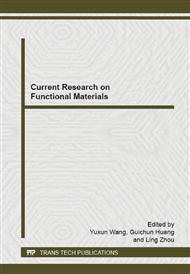[1]
C. Napoli, C. Lemieux and R. Jorgensen, Introduction of a chimeric chalcone synthase gene into petunia results in reversible co-suppression of homologous genes in trans, Plant Cell. 2 (1990) 279-289.
DOI: 10.1105/tpc.2.4.279
Google Scholar
[2]
A. Fire, S. Xu, M.K. Montgomery, S.A. Kostas, S.E. Driver and C.C. Mello, Potent and specific genetic interference by double-stranded RNA in caenorhabditis elegans, Nature. 391 (1998) 806-811.
DOI: 10.1038/35888
Google Scholar
[3]
P.D. Zamore, T. Tuschl, P.A. Sharp and D.P. Bartel, RNAi: double-stranded RNA directs the ATP-dependent cleavage of mRNA at 21 to 23 nucleotide intervals, Cell. 101 (2000) 25-33.
DOI: 10.1016/s0092-8674(00)80620-0
Google Scholar
[4]
C.X. Li, A. Parker, E. Menocal, S. Xiang, L. Borodyansky and J.H. Fruehauf, Delivery of RNA interference, Cell Cycle. 5 (2006) 2103-2109.
DOI: 10.4161/cc.5.18.3192
Google Scholar
[5]
H. Cohen, R.J. Levy, J. Gao, I. Fishbein, V. Kousaev, S. Sosnowski, S. Slomkowski and G. Golomb, Sustained delivery and expression of DNA encapsulated in polymeric nanoparticles, Gene Ther. 7 (2000) 1896-(1905).
DOI: 10.1038/sj.gt.3301318
Google Scholar
[6]
J.F. Engelhardt, X. Ye, B. Doranz and J.M. Wilson, Ablation of E2A in recombinant adenoviruses improves transgene persistence and decreases inflammatory response in mouse liver, Proc Natl Acad Sci USA. 91 (1994) 6196-6200.
DOI: 10.1073/pnas.91.13.6196
Google Scholar
[7]
E.H. Chowdhury. Nuclear targeting of viral and non-viral DNA, Expert Opin Drug Deliv. 6 (2009) 697-703.
DOI: 10.1517/17425240903025744
Google Scholar
[8]
D.G. Anderson, W.D. Peng, A. Akinc, N. Hossain, A. Kohn, R. Padera, R. Langer and A. Janet, A polymer library approach to suicide gene therapy for cancer, Proc Natl Acad Sci USA. 101 (2004) 16028-16033.
DOI: 10.1073/pnas.0407218101
Google Scholar
[9]
P. Chollet, M.C. Favrot, A. Hurbin and J.L. Coll, Side-effects of a systemic injection of linear polyethylenimine-DNA complexes, J Gene Med. 4 (2002) 84-91.
DOI: 10.1002/jgm.237
Google Scholar
[10]
Z. Ma, J. Li, F. He, A. Wilson, B. Pitt and S. Li, Cationic lipids enhance siRNA-mediated interferon response in mice, Biochem Biophys Res Commun. 330 (2005) 755-759.
DOI: 10.1016/j.bbrc.2005.03.041
Google Scholar
[11]
S. Nie, Y. Xing, G.J. Kim and J.W. Simons, Nanotechnology applications in cancer, Annu Rev Biomed Eng. 9 (2007) 257-288.
DOI: 10.1146/annurev.bioeng.9.060906.152025
Google Scholar
[12]
M. Mahmoudi, S. Sant, B. Wang, S. Laurent and T. Sen, Superparamagnetic iron oxide nanoparticles (SPIONs): Development, surface modification and applications in chemotherapy, Adv Drug Deliv Rev. 63 (2011) 24-46.
DOI: 10.1016/j.addr.2010.05.006
Google Scholar
[13]
M.M. Lin, H.H. Kim, H. Kim, J. Dobson and K. do Kim, Surface activation and targeting strategies of superparamagnetic iron oxide nanoparticles in cancer-oriented diagnosis and therapy, Nanomedicine (Lond). 5 (2010) 109-133.
DOI: 10.2217/nnm.09.96
Google Scholar
[14]
W.L. Gui, Comparative study on preparation of contrast agent for abdomen MRI from superparamagnetic Fe2O3 and Fe3O4 microparticles, Research and Exploration in Laboratory. 27 (2008) 32-33, 95.
Google Scholar
[15]
Y.J. Yao, S.D. Miao, S.M. Yu, L.P. Ma, H.Q. Sun and S.B. Wang, Fabrication of Fe3O4/SiO2 core/shell nanoparticles attached to graphene oxide and its use as an adsorbent, J Colloid Interface Sci. 379 (2012) 20-26.
DOI: 10.1016/j.jcis.2012.04.030
Google Scholar
[16]
Z.Y. Lu, J. Dai, X.N. Song, G. Wang and W.S. Yang, Facile synthesis of Fe3O4/SiO2 composite nanoparticles from primary silica particles, A- Physicochem. Eng. Asp. 317 (2008) 450-456.
DOI: 10.1016/j.colsurfa.2007.11.020
Google Scholar
[17]
Y. Lu, Y.D. Yin, B.T. Mayers and Y.N. Xia, Modifying the surface properties of superparamagnetic iron oxide nanoparticles through a sol-gel approach, Nano Lett. 2 (2002) 183-186.
DOI: 10.1021/nl015681q
Google Scholar
[18]
C. Hui, C. Shen, J. Tian, L. Bao, H. Ding, C. Li, Y. Tian, X. Shi and H.J. Gao, Core-shell Fe3O4@SiO2 nanoparticles synthesized with well-dispersed hydrophilic Fe3O4 seeds, Nanoscale. 3 (2011) 701-705.
DOI: 10.1039/c0nr00497a
Google Scholar


